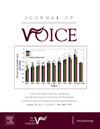Effect of Varied Tube Phonation in Water Exercises on Nasometric and Electroglottographic parameters: Modification in Terms of Fluid Density and Tube Submerged Depth
IF 2.5
4区 医学
Q1 AUDIOLOGY & SPEECH-LANGUAGE PATHOLOGY
引用次数: 0
Abstract
Objective
Within the scope of semi-occluded vocal tract exercises (SOVTEs), we aimed to examine the effects of four exercise combinations, which involved various fluid densities and tube submersion depths, on acoustic and electroglottographic (EGG) parameters.
Methods
Four procedures (P) were applied consecutively to 30 female participants with normal voices using different tube submersion depths and fluid densities, including P1 (2 cm, water), P2 (2 cm, nectar), P3 (10 cm, water), and P4 (10 cm, nectar). Nasometric (Nasometer II model 6450) and EGG (Electroglottograph model 6103) measurements were taken before the procedures were initiated (pre-test) and at the end of each procedure. In addition, EGG measurements were taken for each procedure during the application.
Results
For all three velar positions (oral passage, oro-nasal passage, nasal passage), the only procedure that caused a significant change compared to the pre-test stage in regard to nasalance score was P2 (2 cm nectar) in common. All other procedures except P1 (2 cm water) significantly increased velar closure compared to pre-test levels. However, when the differences between the exercises were examined, the least velar closure, compared to the other procedures, was obtained after P4 (10 cm nectar). While there was no significant difference between the procedures in the EGG measurements during the exercise, a significantly higher tendency to contact was observed after the procedures with a denser consistency, and an increase in the fundamental frequency (fo) values occurred in the pairwise comparisons of the procedures in the measurements after the exercises.
Conclusion
In SOVTEs in which water phonation is performed with a tube, the use of a fluid with a consistency denser than water can be considered a particularly promising approach. In addition, exercises performed with increasing consistencies in 2 cm depth can provide more vocal cord and velopharyngeal port closure by increasing EGG-CQ and nasalance score values. However, more care should be taken while increasing the consistency at a submersion depth of 10 cm.
水中练习中不同管道发音对鼻测量和电子喉参数的影响:流体密度和管子浸没深度的变化。
研究目的在半闭合声道练习(SOVTE)的范围内,我们旨在研究四种练习组合(涉及不同的液体密度和管道浸没深度)对声学和声门图(EGG)参数的影响:方法:对 30 名嗓音正常的女性参与者连续进行了四种程序(P),采用不同的管道浸没深度和液体密度,包括 P1(2 厘米,水)、P2(2 厘米,花露水)、P3(10 厘米,水)和 P4(10 厘米,花露水)。在程序开始前(测试前)和每个程序结束时,均进行了测鼻(测鼻仪 II 6450 型)和 EGG(电子喉镜 6103 型)测量。此外,在应用过程中还对每个程序进行了 EGG 测量:结果:在所有三个声门位置(口腔通道、口鼻腔通道、鼻腔通道)上,与测试前相比,鼻腔平衡得分有显著变化的唯一程序是 P2(2 厘米花蜜)。与测试前水平相比,除 P1(2 厘米水)外,所有其他程序都明显增加了伶牙俐齿的闭合度。然而,当研究不同练习之间的差异时,与其他练习相比,P4(10 厘米花露水)练习后获得的茸毛闭合度最小。虽然在练习过程中的 EGG 测量中各程序之间没有明显差异,但在稠度较高的程序后观察到的接触倾向明显较高,而且在练习后的测量中,各程序的成对比较基频(fo)值均有所增加:结论:在使用导管进行水发声的 SOVTE 中,使用稠度大于水的液体是一种特别有前途的方法。此外,在 2 厘米深度内进行浓度增加的练习,可通过增加 EGG-CQ 和鼻平衡评分值来提高声带和咽鼓管口的闭合度。不过,在增加 10 厘米浸没深度的浓度时应更加小心。
本文章由计算机程序翻译,如有差异,请以英文原文为准。
求助全文
约1分钟内获得全文
求助全文
来源期刊

Journal of Voice
医学-耳鼻喉科学
CiteScore
4.00
自引率
13.60%
发文量
395
审稿时长
59 days
期刊介绍:
The Journal of Voice is widely regarded as the world''s premiere journal for voice medicine and research. This peer-reviewed publication is listed in Index Medicus and is indexed by the Institute for Scientific Information. The journal contains articles written by experts throughout the world on all topics in voice sciences, voice medicine and surgery, and speech-language pathologists'' management of voice-related problems. The journal includes clinical articles, clinical research, and laboratory research. Members of the Foundation receive the journal as a benefit of membership.
 求助内容:
求助内容: 应助结果提醒方式:
应助结果提醒方式:


